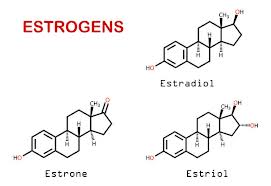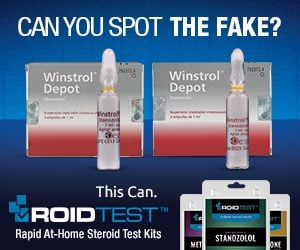What Is Estrogen? What Does It Do? How Does It Work?
The topic of Estrogen is a very interesting one, especially as it pertains to anabolic steroid users, as it is one of the central aspects of anabolic steroid use, particularly where side effects are concerned. But this article is designed to be an all-encompassing informative piece on Estrogen in general as it relates to anabolic steroid use. Estrogen (also called Oestrogen in some countries, particularly in Britain and in countries that use British English) is a group of organic steroid compounds that are of particular importance in female physiology, particularly in the menstrual and estrous cycles of females. A common myth is that ‘Estrogen’ refers to one single hormone, but the truth is that estrogens are a group of related female steroid hormones. Although Estrogens are steroid hormones, they are not anabolic steroids in the sense that they do not have any direct facilitation of muscle anabolism. In fact, the majority of steroid hormones, like Estrogen, have nothing to do with muscle building.
 There exist three primary Estrogens in females: Estrone (E1), Estradiol (E2), and Estriol (E3). All three of these Estrogens are naturally occurring in females, and are steroidal in nature. However, there are some synthetic Estrogens that are non-steroidal as well. Each of the three primary Estrogens serve different roles in female physiology. Thus, we can see here how Estrogen does not refer to one specific hormone (as the term is commonly misused), but refers to a broad category of related hormones. The same is true for the male counterpart, androgens, which consist of Testosterone, Dihydrotestosterone, and various others male androgens. Estrogen occurs naturally in all vertebrates[1] and in some insects[2]. In females, Estradiol is the primary Estrogen, especially during the peak of a female’s reproductive years, and is the strongest of the three Estrogens. The balance shifts later on, however, as Estrone levels increase and become dominant during the menopausal years. Estriol, although the most abundant Estrogen, is the weakest, and is the Estrogen that is most dominant during a female’s pregnant years. Finally, there is one more Estrogen, and that is Esteterol (E4), which is only present during pregnancy in females.
There exist three primary Estrogens in females: Estrone (E1), Estradiol (E2), and Estriol (E3). All three of these Estrogens are naturally occurring in females, and are steroidal in nature. However, there are some synthetic Estrogens that are non-steroidal as well. Each of the three primary Estrogens serve different roles in female physiology. Thus, we can see here how Estrogen does not refer to one specific hormone (as the term is commonly misused), but refers to a broad category of related hormones. The same is true for the male counterpart, androgens, which consist of Testosterone, Dihydrotestosterone, and various others male androgens. Estrogen occurs naturally in all vertebrates[1] and in some insects[2]. In females, Estradiol is the primary Estrogen, especially during the peak of a female’s reproductive years, and is the strongest of the three Estrogens. The balance shifts later on, however, as Estrone levels increase and become dominant during the menopausal years. Estriol, although the most abundant Estrogen, is the weakest, and is the Estrogen that is most dominant during a female’s pregnant years. Finally, there is one more Estrogen, and that is Esteterol (E4), which is only present during pregnancy in females.
Although Estrogen is the primary female hormone, small amounts of Estrogen are present in males and is responsible for maintaining a number of health-related functions that will be covered in this article shortly. The same is true for the male androgen Testosterone, which is present in males in very large quantities but is present in females in only minimal amounts.
Estrogen exerts its activity through the same method that all steroid hormones operate: Estrogens, being highly fat-soluble hormones, easily diffuse through the cell membrane into their target cells. Following diffusion through the membrane into the cell, the Estrogen will then bind with the Estrogen receptor (ER) to form a steroid hormone receptor complex. This hormone-receptor complex then travels into the nucleus of the target cell, where the cell’s genes are activated. On a broader scale, this results in cells engaging in a particular job or behavior. In the case of breast tissue, for example, Estrogen binding to and activating the Estrogen receptor here results in the formation of breast tissue (also known as gynecomastia).
Estrogen serves a special role in organisms. Specifically, it is responsible primarily for the promotion of female secondary sex characteristics, it increases fat storage, reduces bone resorption (but increases bone formation), increases HDL (good) cholesterol, decreases LDL (bad) cholesterol, controls sodium and water retention, acts as an anti-inflammatory, an immunomodulator, cardiovascular function, and a whole plethora of other effects on the body (both positive and negative effects, depending on the conditions and circumstances).
How Is Estrogen Manufactured In Men and Women?
In females in the ovaries, Testosterone and Androstenedione act as precursors for the production of Estrogen, and Estradiol is the primary estrogen manufactured in the ovaries in females through the process of aromatization[3]. Aromatization is basically the conversion of androgens (such as Testosterone) into Estradiol (E2), and the enzyme responsible for this conversion is the aromatase enzyme. In men, Estrogen is manufactured via the same process of aromatization, however different tissues such as the gonads[4], the central nervous system[5], the liver[6], skeletal muscle tissue[7], and adipose tissue (fat tissue)[8] [9] are where notable amounts of aromatization occur, and these are tissues that commonly contain higher levels of the aromatase enzyme than others. This is what is responsible for the small level of Estrogen that is present in men, while the process and rate of aromatization in females is far greater, resulting in a much higher level of Estrogen in women than in men.
All Estrogens are synthesized through aromatization via the aromatase enzyme. With the aromatase enzyme being the enzyme responsible for the production of Estrogen in both men and women, we will see how this pertains very importantly to the anabolic steroid user shortly.
Estrogen and Anabolic Steroid Use
As previously mentioned, Estrogen is of particular importance and concern to those who use anabolic steroids by virtue of the fact that some anabolic steroids, being analogues of the male androgen Testosterone, are aromatizable. That is to say that some anabolic steroids can aromatize into Estrogen (E2). In fact, Estrogen levels are a paramount concern when anabolic steroid use is considered, as estrogenic side effects are probably one of the most focused-upon aspects of anabolic steroid use and anabolic steroid side effects. Rising Estrogen levels as a result of large amounts of aromatization of androgens such as Testosterone can cause a host of side effects and health problems that Estrogen is directly responsible for.
This is not to say that Estrogen is a ‘bad’ hormone, however. Estrogen is not an evil hormone for the bodybuilder or the athlete, or anyone for that matter. It is in fact a very important hormone that is very necessary in normal physiologic levels. Too much Estrogen is not good, but too little of it is not good either. Lower than normal physiological levels of Estrogen carries with it a whole host of negative health problems and side effects as well. Too often do members of the bodybuilding and athletic community take concepts to extremes and such is the case with Estrogen, with many individuals advocating the complete reduction of Estrogen levels with aromatase inhibitors, and so on and so forth.
The aromatization of anabolic steroids such as Testosterone, Dianabol (Methandrostenolone), and Equipoise (Boldenone), just to name a few, can result in Estrogen levels rising above normal physiological levels and lead to potential side effects such as gynecomastia, bloating, water retention, prostate effects, and acne. At the same time, Estrogen plays some very important key roles in the human body (within males and females alike) that offsets many potential ill effects or dangers of anabolic steroid use. These include improvements in cholesterol profiles, cardiovascular function, male sexual function, fertility, bone strength/function, and more. Thus, it is important that Estrogen be viewed upon in a balanced and fair perspective rather than one of extreme bias, as we will see throughout this article.
Medical References:
[1] Ryan KJ (August 1982). “Biochemistry of aromatase: significance to female reproductive physiology”. Cancer Res. 42 (8 Suppl): 3342s–3344s. PMID 7083198.
[2] Mechoulam R, Brueggemeier RW, Denlinger DL (September 2025). “Estrogens in insects”. Cellular and Molecular Life Sciences 40 (9): 942–944. doi:10.1007/BF01946450.
[3] Hadley M, Levine J. 2006. Endocrinology. 6th ed. Toronto: Pearson Education, pp. 372.
[4] Brodie A, Inkster S, Yue W. Aromatase expression in the human male. Mol Cell Endocrinol. 2001 Jun 10;178(1-2):23-8.
[5] Lephart ED. A review of brain aromatase cytochrome P450. Brain Res Brain Res Rev. 1996 Jun;22(l):1-26.
[6] The aromatization of androstenedione by human adipose and liver tissue. J Steroid Biochem. 1980 Dec;13(12):1427-31.
[7] Matsumine H, Hirata K, Yanaihara T, Tamada T, Yoshida M. Aromatization by skeletal muscle. J Clin Endocrinol Metab. 1986 Sep;63(3):717-20
[8] Aromatization of androstenedione and 19-nortestosterone in human placental, liver, and adipose tissues (abstract). Nippon Naibunpi Gakkai Zasshi. 62 (1986:18-25).
[9] Longcope C, Pratt JH, Schneider SH, Fineberg SE. Aromatization of androgens by muscle and adipose tissue in vivo. J Clin Endocrinol Metab 1978 Jan;46(l ):146-52





